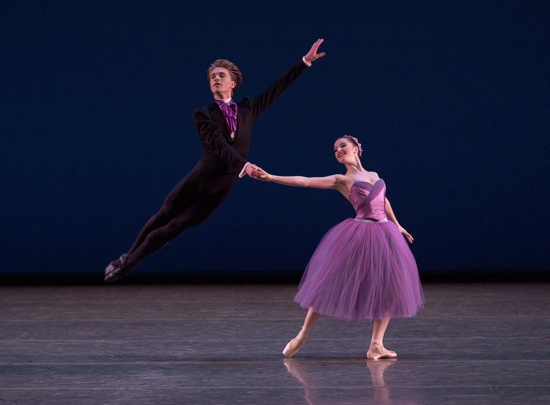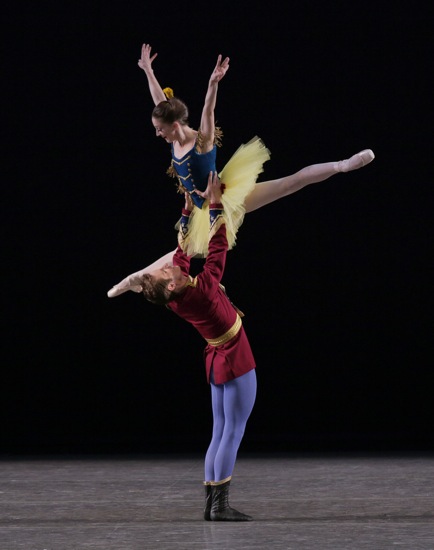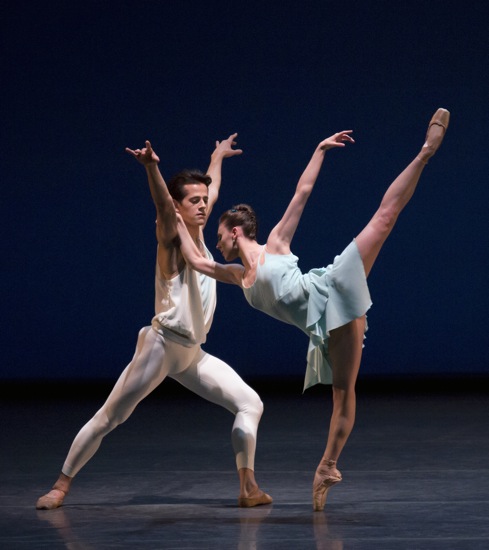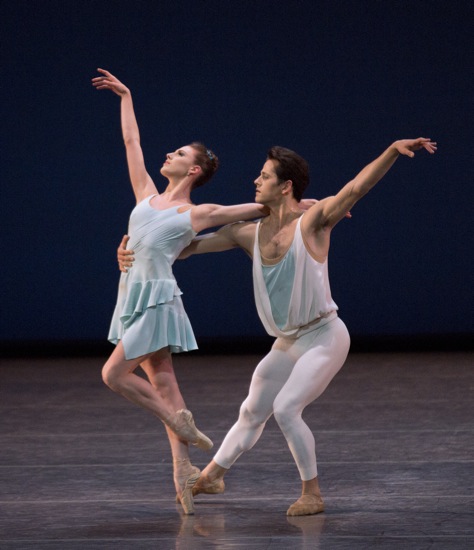New York City Ballet, Lincoln Center, April 30 through June 9

Front, L to R: Brittany Pollack and Taylor Stanley, Sara Adams and Harrison Ball, Indiana Woodward and Peter Walker, Lauren Lovette and Chase Finlay, Kristen Segin and Ralph Ippolito of the New York City Ballet in Christopher Wheeldon’s Soirée Musicale. Photo: Paul Kolnik
In the Spring of 1988, the New York City Ballet put on an American Music Festival. George Balanchine had been dead for five years, and the two Ballet Masters in Chief, Peter Martins and Jerome Robbins, commissioned enough new ballets to keep dancers, guest choreographers, and resident choreographers rushing in and out of the company’s studios, gnawing on health bars. Was this Eliot Feld’s rehearsal? No, it was Bart Cook’s. Then when was Martins scheduled? Not too many memorable works emerged.
For the 25th anniversary of this prolific venture, Martins wisely kept the plan modest in scale. Among the 25 ballets showcased as the American Music Festival during the first three weeks (April 30-May 19) of NYCB’s Spring Season are revived treasures like George Balanchine’s beautiful and mysterious Ivesiana (1954) and Peter Martins’ terrific first ballet for the company, the 1977 Calcium Light Night (also set to music by the American maverick Charles Ives). And only two works are premieres.
The excellently designed program for the season’s gala on May 8 featured music by Samuel Barber, André Previn, Leonard Bernstein, Philip Glass, George Gershwin, and John Philip Sousa, and choreography by Balanchine, Robbins, and Christopher Wheeldon, whose Soirée Musicale and new A Place for Us were the only ballets performed in their entirety.
Barber’s Souvenirs Ballet Suite isn’t new to NYCB’s repertory. The music was commissioned by Balanchine and Lincoln Kirstein for Todd Bolender’s Souvenirs (1955), a comedic romp set at a resort hotel circa 1914. The very young Christopher Wheeldon used the music for the very different ballet that he choreographed for the students at the School of American Ballet in 1998. Soirée Musicale is that ballet. In reviving it for the NYCB, Wheeldon has added a new pas de deux.

Harrison Ball and Indiana Woodward in the “Two-Step” of Wheeldon’s Soirée Musicale. Photo: Paul Kolnik
The French title seems reasonable, given that Barber’s music doesn’t sound overtly American, and Holly Hynes’s very pretty costumes, with their layered net gowns for the women and ballet’s version of black-tie for the men, have a romantic aura. The bit of black drapery hanging at the rear of the stage isn’t exactly festive, but the ballet is clearly a dance party, beginning with couples waltzing to the kind of music that demands swirling around in a decorous embrace.
Wheeldon draws other ideas out of ballroom dancing, though. For a while during Barber’s opening “Waltz,” three couples explore all the ways they can revolve without leaving the spot they’re standing on. The men turn the women and circle them; holding each other’s hands, partners weave and unweave in bewitching ways, as if warming up for the waltzing and running about that they’re eager to get back to.
The “Schottische” brings out the perkiness in Kristen Segin and Indiana Woodward. They flutter around each other and hold hands in skaters’ position to sprint around the stage. The arrival of a man (Ralph Ippolito) incites a bit of vying for his attention. But, although polite, he has to go elsewhere. Same with Peter Walker (or was Walker the first and Ippolito the second?). Left to themselves, the women are best friends again.
Here’s what happened to the men. They heard about lovely Brittany Pollack, and heard the orchestra strike up Barber’s unmistakably slinky “Tango.” Pollack starts out with three suitors. Two more arrive shortly. Now she has a partner and four guys in waiting. She plays fair—falling into each one’s arms in turn. That becomes impractical, as more men arrive. Twelve cavaliers expressing interest display themselves neatly. But just before the end of the music, most of this dapper army departs, leaving Pollack again with a trio of men. How could Wheeldon resist giving a nod to Balanchine’s Apollo? The three grab her hands and urge her on: three godlings, one saucy muse leading them astray.
Woodward and Segin team up with Sara Adams and two men (Harrison Ball and Taylor Stanley) for the “Two-Step.” But the principal two-step of the ballet is Wheeldon’s new pas de deux for recently minted principal Chase Finley and Lauren Lovette (a lovely dancer, who has just been promoted to the rank of soloist). Wheeldon has always shown a gift for pas de deux. He adds a warmth to classicism without mangling it. This duet is fresh and full of small inventions—much more than an amuse-bouche on the way to the ballet’s “Finale.” The evening’s pairings and flirtations have spawned some sweet-natured intimacy.
Wheeldon attached a note to his world premiere, A Place for Us. It reads: “For Jerome Robbins. A thank you,” and the title is drawn from West Side Story, the musical that made Robbins famous around the world. This duet for Tiler Peck and Robert Fairchild has the quietness that Robbins prized in ballets of this kind. No visible effort, he believed, should mar a behavior as close to natural as ballet choreography (and ballet dancers) could come.
Peck and Fairchild—marvelous dancers and expressive performers— are perfectly cast. On the night of the gala, they had the pleasure of dancing to wonderfully performed music. As played onstage by NYCB’s excellent and versatile pianist Nancy McDill and a great guest clarinetist, Richard Stoltzman, the “Interlude” from Previn’s Clarinet and Piano Sonata elided fluently into Bernstein’s Sonata for Clarinet and Piano.
The duet begins as the two dancers walk slowly into a rectangle of light that designer Penny Jacobus has laid on the floor. Stoltzman and McDill move into a spare, soft-voiced instrumental dialogue as the pace picks up. New windows of light appear for Peck and Fairchild to step into. There are some lovely images. When she walks backward, holding his hand as he advances toward her, he looks down for a moment at their clasped hands and then up at her, as if acknowledging that this relationship is growing on him. Three times, she runs toward him, and he dips just enough so that she’s caught mid-air on his shoulder—no grasping hands visible. Yet, difficult as this maneuver may be, it’s anything but bravura. The dancers act as if this were simply a delightful step into intimacy that they want to savor.
When Previn’s “Interlude” ends and Bernstein’s Sonata begins, the atmosphere becomes more playful and the dancers perkier. Peck pushes Fairchild offstage, but seconds later he rushes back. He sits and watches her dance (a very Robbins touch) and claps his hands when she finishes. Stolztman’s clarinet winds her up, and she’s spinning like a top as the curtain descends. (Stoltzman, too, was wound up; he bounced from his stool to join McDill and the cast for a curtain call with an exhuberant little “tour en l’air.”)
Robbins’s own choreography was represented on the gala evening by “Cool” from West Side Story Suite (1995) and an excerpt from Glass Pieces (1983). It’s always fun to see the NYCB men crouching and running and looking tough in the choreography drawn from the musical. They also yell and sing. Andrew Veyette as their leader manages the song very well, although the miking made him sound hollow in a strange way, and his enunciation isn’t spic-and-span. At this performance, without the earlier scenes in the ballet to get them on edge, the Jets didn’t all have the nervy, electric energy that “Cool” needs. The gang has to be simmering toward a boil for the song to convey its message fully.
The excerpt from Glass Pieces rides and digs into the powerful pulse and deep, braying horns of the “March” taken from Philip Glass’s opera Akhnaten. Conducted by Daniel Capps (Clotilde Otranto led the orchestra in West Side Story Suite), the score takes no prisoners. You imagine that if one dancer stumbled and fell, the others would just have to trample a comrade. The twenty-four men and women are always on the move—coming and going in squads, working their way into lines and circles and multiple curves. Sometimes they stride out in almost two-dimensional positions—perhaps Robbins was alluding to the “Egyptian” aspect of the music—and balletic maneuvers are avoided. They’re like athletes warming up for some game we don’t get to see. Or maybe this is the game, and we just don’t know the rules. Like Glass, Robbins blew minimalism into fascinating complexity.
Additional pas de deux showed two of Balanchine’s many sides. On this special night, “The Man I Love” from Who Cares received a new look. Andrews Sill led the orchestra through Hershy Kay’s orchestration of Gershwin’s song, with Cameron Grant as the solo pianist. But guest performer Queen Latifah strolled onstage to sing it for us. Shimmering in a silver-sequined gown, she delivered the words warmly and caressingly—avoiding personal tempo changes that might endanger the choreography, yet with some individual touches. Amar Ramasar partnered Sterling Hyltin, who seems more radiantly alive each time I see her dance.

Ashley Bouder and Andrew Veyette in the Fourth Campaign of Balanchine’s Stars and Stripes. Photo: Paul Kolnik
The night-under-the-stars ambiance of that music was succeeded by the full sun of the duet that makes up the “Fourth Campaign” of Stars and Stripes, with Ashley Bouder as saucy “Liberty Bell” (“belle” is more like it) and Veyette as her strutting partner, “El Capitan.” They make a charming pair, and Balanchine obviously relished the happy bombast of Kay’s adaptation and orchestration of Sousa marches. This is a duet for jumpers who can flash their legs in the air at top speed, and Bouder and Veyette fill the bill. Their flirtation isn’t easy, nor is she demure; the man has to duck every time he turns his partner, since her arabesque could easily smack him in the gut (or worse).
When two squads of women and one of men (that we normally see earlier when Stars and Stripes is performed in its entirety) march onto the stage, their advent comes as a big, happy surprise. Balanchine’s forays into Americana always balance a tongue-in-cheek approach to stereotypes with genuine affection for the customs and foibles of the choreographer’s adopted country. As the huge flag is pulled up to end the ballet, let us this time salute America’s contributions to music history and to the repertory of our cherished native ballet company.




DJ concludes: “As the huge flag is pulled up to end the ballet, let us this time salute America’s contributions to music history and to the repertory of our cherished native ballet company.”
Unfortunately, the summer home of the NYCB, Saratoga Performing Arts Center, doesn’t see it that way. They’ve cut the City Ballet back to a mere one-week residency, and have blamed the company for “not getting its financial matters in order.” A real tragedy.
I live in Saratoga Springs, New York. Saratoga has been fortunate to have been the “summer home of the New York City Ballet” for nearly 50 years. For those who may not know, The Saratoga Performing Arts Center was the combined vision of George Balanchine, Lincoln Kirstein, Eugene Ormandy, Nelson Rockefeller and local area arts enthusiasts, all of whom banded together to make the Arts Center a reality. The opening of the facility brought with it great excitement and, over the years, the audience has grown to a respectable size (generally equal to that at Koch Theather), averaging about 2,000 for each NYCB performance.
However, the Arts Center has been plagued by poor management for at least the last 35 years. Eight years ago, the Executive Director at that time made the huge gaffe of voting with the Board to drop City Ballet from any future appearances. There was a huge outcry from the community and, ultimately, amid much hubbub, the President and Board were replaced.
At that time, NYCB appeared here for three weeks each year in July. Their residency now stands at one week, with no guarantee that they will return in 2014, or still be appearing here for their 50th anniversary season in 2016. It is clear to me that this downturn is due to an artistically uninformed Board and a President who knows nothing about arts management. There are no grants sought, no Capital Fund Drives, there has never been an Endowment Fund Drive and, in general, they look no farther than the wealthiest among the local residents for fundraising.
Why am I writing this in response to the wonderful review written by Deborah Jowitt, above? Because for this entire week, I have read only rave reviews of the company”s Gala performance in newspapers and magazines. Saratoga Springs was given an historic opportunity to treasure and nurture NYCB but, apparently, we don’t care enough to put in the effort to keep this world-class, amazing, dance company here. We don’t know what we have. Michael Bloomberg and Deborah Jowitt know. Dance Magazine, Daniel Wakin and the generous donors who contribute to NYCB know. I wonder if those of you who know the value of City Ballet and its dancers and who read this column have any ideas to save the situation.
I love NYCB. I would do whatever needs to be done to make their tenure here continue so that future generations can experience what I have known, a true “Midsummer Night’s Dream,” where one can transcend this ordinary life for the joyous and beautiful summer world of the New York City Ballet, dancing, surrounded by pine trees, fireflies and a sweet sunset in the woods.
I’m very glad that Don Drewecki and Lisa Mehigan spoke out about the New York City Ballet’s shrunken summer season and the Saratoga Performing Arts Center. it seems incomprehensible that SPAC’s management wouldn’t consider that the company’s seasons brought tourists to the area and shoppers to the town center. It’s no accident that the National Museum of Dance opened there.
A small correction about Samuel Barber’s Souvenirs–Todd Bolender, by his own account, heard this music and wanted to make a ballet. He was then delighted to learn that City Ballet owned the score, that Barber was not pleased by what Balanchine proposed to do with it, and Balanchine evidently shrugged and said, okay, you try. The result was Souvenirs, the first production designed for City Ballet by Reuben ter Arturian. Kansas City Ballet performed the ballet last spring when the Bolender Center there was inaugurated and I frankly think it’s a shame that City Ballet no longer has it in active rep. Nevertheless, Deborah’s description of the Wheeldon does make me want to see it with mine own eyes; I too admire his touch with pas de deux.
Thank you, Deborah, for your response.
How can it be All American when they take lots of NEA money paid by the entire American tax payers but never can be found performing anywhere except New York. If they want to be All American they should get out of New York, spend some of our non-New York tax money performing in Kansas City, Seattle, Salt Lake City, Spokane and Albuquerque. American west of New York does not stop at the Hudson River.
Dear Deborah,
Great thanks for your warm words of admiration and detailed description of NYCB Gala. It is like being there at the performance. NYCB is a great company and they deserve nice words and long ovations for their woderful work!